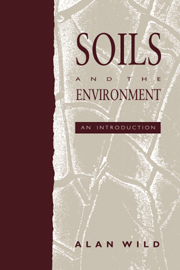Book contents
- Frontmatter
- Contents
- Preface
- Acknowledgements
- Units, symbols and general information
- 1 Introduction: soil in a natural and man-made environment
- A Soil properties and processes
- B Soils in relation to the environment
- 7 Soil as a medium for plant growth
- 8 Soil conditions and crop production
- 9 Soil acidification
- 10 Heavy metals and radionuclides in soil
- 11 Soils, the atmosphere, global warming and ozone depletion
- 12 Soil erosion and conservation
- 13 Soils in the environment: problems and solutions
- Suggestions for further reading
- Index
12 - Soil erosion and conservation
Published online by Cambridge University Press: 06 January 2010
- Frontmatter
- Contents
- Preface
- Acknowledgements
- Units, symbols and general information
- 1 Introduction: soil in a natural and man-made environment
- A Soil properties and processes
- B Soils in relation to the environment
- 7 Soil as a medium for plant growth
- 8 Soil conditions and crop production
- 9 Soil acidification
- 10 Heavy metals and radionuclides in soil
- 11 Soils, the atmosphere, global warming and ozone depletion
- 12 Soil erosion and conservation
- 13 Soils in the environment: problems and solutions
- Suggestions for further reading
- Index
Summary
Introduction
Soil erosion is the removal of part of the soil, or the whole soil, by the action of wind or water. It is a natural process that occurs without human intervention but it can be greatly increased by cultivation of theland. Indeed, there has been serious erosion as long as there have been farmers. In the northern mountains of ancient Mesopotamia soil erosion is associated with the early, and probably the first, farmers about 10000 years ago. It is believed to have been caused by the felling of trees, cultivation of the cleared land and overgrazing by sheep and goats. The same causes led to erosion of soil from the highlands in Ethiopia, Greece and Italy. Erosion in northern Europe is believed to have begun with the clearing of woodlands about 5000 years ago. European settlers in North and South America and Australia were generally unaware of the potential hazards of clearing and cultivating land that was subject to drought and severe rainstorms. Water erosion, and wind erosion of the kind that occurred in the Great Plains of the USA in the 1930s, had devastating effects. The clear-felling of forests on steep slopes and in the humid tropics followed by cultivation is continuing to cause erosion which is at least as serious as any that has occurred in the past.
The results of erosion may not be entirely negative. For example, sediment derived from erosion in Ethiopia helped to sustain Egyptian agriculture for thousands of years.
- Type
- Chapter
- Information
- Soils and the Environment , pp. 233 - 248Publisher: Cambridge University PressPrint publication year: 1993



